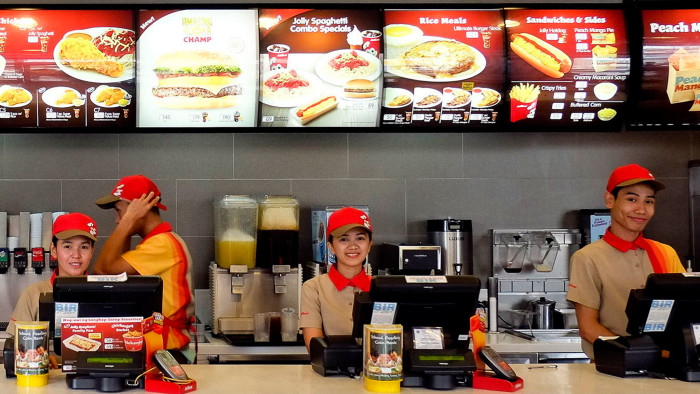Emerging market challengers gain ground despite slowdown

Roula Khalaf, Editor of the FT, selects her favourite stories in this weekly newsletter.
Catching up can be hard to do. But while many emerging market economies have hit the skids in the past couple of years, an aggressive cohort of multinational companies from developing countries has continued to rise steadily.
Emerging market companies are using a medley of strengths — including significant cost advantages, a deeper understanding of regional markets and robust relationships with stakeholders, governments and customers — to grow by winning market share from established US and European multinationals.
BCG, a management consultancy, estimates that the number of companies in Asia with more than $1bn in annual revenues jumped sixfold between 2003 and 2013 to a total of 1,015. Many of these companies are emerging multinationals or have ambitions to expand overseas — and almost all of them compete with established multinationals in their home markets. In Latin America, Africa and the Middle East the pace of corporate growth is slower but still impressive, BCG data show. There were about 700 corporations in these regions with annual revenues in excess of $1bn in 2013, double the number seen a decade earlier.
The recent slowdown in headline GDP growth in several emerging markets — notably recession-hit Russia, Brazil, and South Africa — has affected the growth rates of many corporate challengers from the developing world, says Christoph Nettesheim, senior partner at BCG in Singapore. “Nevertheless, I would say that emerging market companies are still winning market share from multinationals overall, despite the slowdown that we have seen in the last couple of years,” Mr Nettesheim says.
In addition, longer term structural trends may be helpful to emerging multinationals. The urban population of developing countries is set to grow by 600m by 2020, a year by which some 6.4bn people out of a global population of 7.5bn are expected to live in emerging economies.
In this report, FT correspondents in Asia, Latin America and Europe profile companies that are making regional or global waves, illustrating shifts in the competitive landscape whether in vehicles, renewable energy, construction, luxury goods or food and drink.
Chinese companies loom large across several sectors. In some cases, such as the expansion of Chinese automakers into the Brazilian market, an internationalising verve is represented by mostly private companies that have survived a cauldron of competition at home and are now attempting to build their brands in foreign climes.
But Brazil also shows how foreign headwinds can stunt emerging ambitions. The arrival of these Chinese companies in the world’s fourth-largest car market preceded a meltdown in Latin America’s biggest economy by just a few years, forcing the automakers to offer deep discounts and hampering nascent sales growth. In spite of the turbulence, some market share has been won, but some plans to localise production in Brazil have been put on hold because of modest sales volumes.
In other sectors, the power of the Chinese state reinforces overseas forays. Infrastructure construction companies and construction equipment companies have been riding on the coattails of finance provided by two huge state-owned development or “policy” banks — the China Development Bank and the Export-Import Bank of China. These now lend almost as much as the six western-backed multilateral development institutions put together.
At the end of 2014, the two Chinese state-owned development banks had outstanding loans to overseas borrowers amounting to an estimated $684bn, just short of the $700bn owed to the World Bank, Asian Development Bank, Inter-American Development Bank, African Development Bank, European Investment Bank and the European Bank for Reconstruction and Development, according to a study by Boston University and the Chinese Academy of Social Sciences.
Most of the Chinese development finance is for infrastructure projects, preparing the ground for large homegrown companies to win construction contracts.
These contractors, in turn, tend to prefer Chinese construction-equipment companies, such as Sany and Zoomlion, as suppliers.
The financial firepower of Chinese development institutions is unlikely to dissipate as Beijing rolls out its “One Belt, One Road” initiative, a grand design to build infrastructure in more than 60 countries between China and Europe requiring an estimated investment of about $900bn over the next decade.
But China is by no means the only springboard for emerging multinationals. Jollibee Foods, the Philippine owner of fast-food brands worldwide, shows that a successful multinational can emerge from almost anywhere in the developing world, given a strong home base and judicious internationalisation strategy.
Not only has Jollibee built up a chain of noodle restaurants in China under the Yonghe Dawang brand, it has taken on the US burger market with the recent acquisition of a 40 per cent stake in Smashburger, which is contributing to its healthy growth in the North American market.
The experience of Indian business consultancy multinationals such as Tata Consultancy Services, Infosys and Wipro, however, shows that effective international strategies that have worked in the past may need updating.
Clients who once had healthy appetites for outsourcing are now automating these processes in-house, putting pressure on the Indian companies to offer innovative and better value-added services that cannot be accomplished by that mass hiring of low-paid Indian graduates.
As a result, and to stay relevant to clients in a changing world, these former trailblazers for fast-growing emerging multinationals more than a decade ago, must rethink their strategies to offer more creative products and services.
Comments